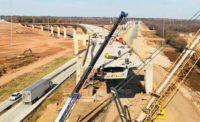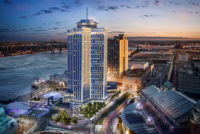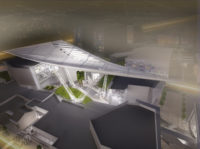After two years of delays, crews are in the final stages of construction on a $63.7 million project to broaden a 1.6-mile section of U.S. 90 in Broussard to make it part of the future I-49 corridor between Lafayette and New Orleans. The design-build project involves widening U.S. 90 from four to six lanes from Albertson Parkway to north of the Ambassador Caffery intersection in Lafayette, bringing the corridor up to interstate standards.
“Even though it took a little longer than expected, this is a great project that’s going to bring a lot of economic growth—not only to Broussard, but to the surrounding areas,” says David Mann, chairman of the I-49 South Coalition, an organization of businesses working toward the corridor’s completion.
Whereas the four-lane highway had no access control, the six-lane corridor will feature an adjacent system of frontage roads that connect to highways, ramps and businesses, and includes a tie-in to U.S. 182. The project also calls for the construction of an overpass along U.S. 90 above Albertson Parkway and a new railroad overpass. Louisiana Dept. of Transportation (DOTD) spokeswoman Brandie Richardson says this is the only project of its type in the area.
The project is part of the DOTD’s Geaux South program, a $3 billion construction initiative to convert approximately 160 miles of U.S. 90 into Interstate 49 South. The corridor will stretch from the I-10/I-49 North junction in Lafayette to the Westbank Expressway in New Orleans.
In 2014, the DOTD awarded a $57.1 million contract to James Construction Group of Baton Rouge to construct the project, which began that summer and was planned for completion three years later. But heavy rains, unprecedented flooding and other issues delayed the project another two years and drove up the cost by $6.6 million.
Historic Flooding Creates Setbacks
Weather conditions led to significant setbacks. South Louisiana, including Lafayette, experienced catastrophic, widespread flooding in August 2016. The project site also experienced above-average rainfall in 2016, 2017 and 2018. “Each of these weather effects slowed progress of construction, including not being able to place asphalt during the winter months due to temperature restrictions,” Richardson says.
Among other causes for the delays, DOTD officials previously cited design issues, management issues and delays in getting materials, and the fact that there were numerous subcontractors on the project.
A significant challenge has been for crews to perform the work in three phases while trying to maintain traffic flows in a busy urban setting. Nearly 42,000 vehicles travel the corridor daily. Because of project phasing, crews had to build one lane at a time next to existing travel lanes, which slowed the process.
“In doing each phase, hurricane evacuation had to be considered, as U.S. 90 is a major hurricane evacuation corridor for south Louisiana,” Richardson says.
To keep the project moving forward, lane closures for major construction operations took place at night.
The project team had to import all materials for the earthwork embankment, as existing materials were not suitable for construction. But because work took place at night, there were issues with delivering materials, including girders, to the site. The project called for 9,924 cu yds of structural concrete, 3,576 lbs of structural metalwork and nearly 2.3 million lbs of deformed reinforcing steel. There were also 22,097 linear ft of precast, pre-stressed concrete girders and 86,154 tons of asphalt.
Mechanically stabilized earthen (MSE) wall panels and specialty pre-stressed concrete girders were precast and delivered to the site. Workers used non-plastic embankment instead of dirt embankment, and 12-in stone base in place of soil cement base in selected locations. By using mechanically stabilized walls, the design-builder was able to construct the entire project within the existing right of way.
The project team was able to create efficiencies by relying on digital surveying technology and 3-D modeling for grading. The asphalt-paving contractor used 3-D modeling to place the final lift of asphalt, which made it possible for one person to perform an operation that normally requires three or four people.
To expedite structural excavation for the bridge substructure footings, the project team used trench boxes instead of driving sheet piles.
Overpasses Present Challenges
Design and construction of overpasses called for special considerations. The Albertson Parkway overpass was positioned at a major urban intersection and required a major construction sequence to complete the bridge structure. The project team also had to consider the vertical clearance of the overpass above Albertson Parkway during the design-build process.
The BNSF railroad overpass was located on a significant skew, which complicated the design and constructability of the bridge structure. The project team had to design and build the overpass in three separate phases. “In addition, both the horizontal and vertical clearances from the existing and future tracks had to be adhered to, including designing and constructing pier projection,” Richardson says.
The project incorporated two existing Burlington Northern Santa Fe (BNSF) Railway overpasses into the phased design, so the contractor did not have to construct a detour bridge.
Wrapping Up
The completion of the U.S. 90 expansion at Albertsons Parkway will be critical to the progress of the I-49 South corridor project in Lafayette, Mann says, especially after the corridor received a surprise cash infusion of $150 million from the state in early June. The funding is part of a $690 million spending plan for state infrastructure projects. The plan received final approval from lawmakers, and the $150 million will help fund other future I-49 South projects.
“It will do wonders for that area and for the rest of the region for I-49 South,” Mann says. “We’re excited about [the project] being finished, and we can now focus on other parts of I-49 South being completed.”
Remaining work includes final asphalt paving for frontage roads and on/off ramps; permanent roadway striping, signs and raised pavement markers; permanent grass seed on the roadway for slopes; new traffic signals at the intersection of Albertson Parkway and the adjacent frontage roads; and final project cleanup.
Work is slated for completion in late June, weather permitting.







Post a comment to this article
Report Abusive Comment